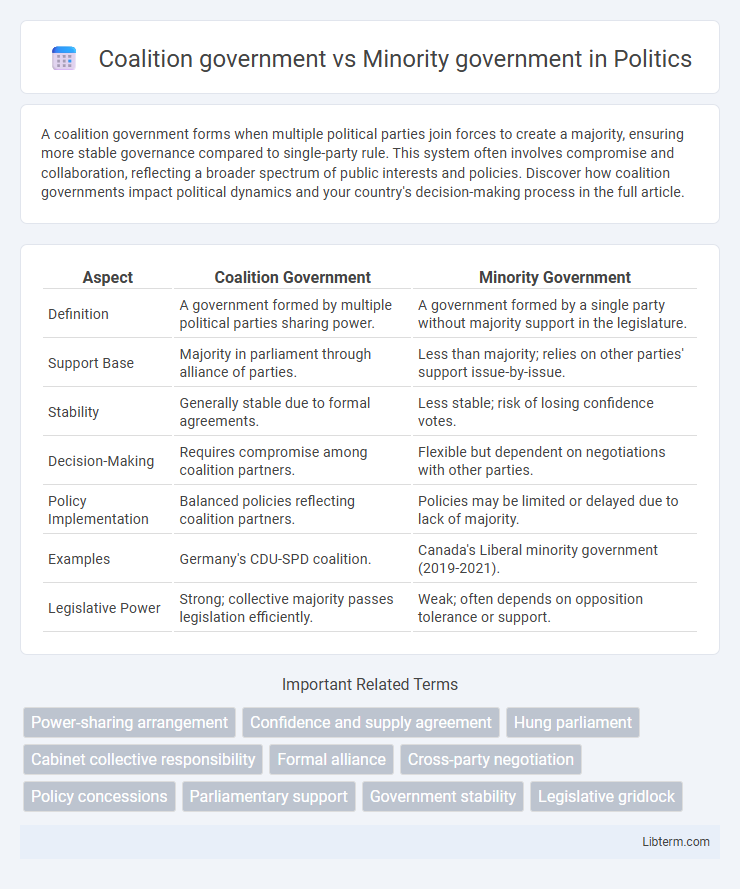A coalition government forms when multiple political parties join forces to create a majority, ensuring more stable governance compared to single-party rule. This system often involves compromise and collaboration, reflecting a broader spectrum of public interests and policies. Discover how coalition governments impact political dynamics and your country's decision-making process in the full article.
Table of Comparison
| Aspect | Coalition Government | Minority Government |
|---|---|---|
| Definition | A government formed by multiple political parties sharing power. | A government formed by a single party without majority support in the legislature. |
| Support Base | Majority in parliament through alliance of parties. | Less than majority; relies on other parties' support issue-by-issue. |
| Stability | Generally stable due to formal agreements. | Less stable; risk of losing confidence votes. |
| Decision-Making | Requires compromise among coalition partners. | Flexible but dependent on negotiations with other parties. |
| Policy Implementation | Balanced policies reflecting coalition partners. | Policies may be limited or delayed due to lack of majority. |
| Examples | Germany's CDU-SPD coalition. | Canada's Liberal minority government (2019-2021). |
| Legislative Power | Strong; collective majority passes legislation efficiently. | Weak; often depends on opposition tolerance or support. |
Understanding Coalition Governments
Coalition governments form when multiple political parties collaborate to achieve a majority in a parliamentary system, sharing power and responsibilities to ensure stable governance. This often involves negotiated agreements on policy priorities and cabinet positions, promoting broader representation and consensus-driven decision-making. In contrast, minority governments govern without a parliamentary majority, relying on case-by-case support from opposition parties, which can lead to less stability and more frequent elections.
Defining Minority Governments
Minority governments occur when the ruling party holds fewer seats than the combined opposition, relying on external support to pass legislation and maintain confidence. Unlike coalition governments, which form through formal alliances between multiple parties to secure a majority, minority governments often negotiate issue-by-issue support without fixed agreements. This dynamic can lead to less stable governance and increased negotiation with opposition parties on key policy decisions.
Key Differences Between Coalition and Minority Governments
Coalition governments form when multiple political parties cooperate to create a majority, sharing power and responsibilities, whereas minority governments consist of a single party lacking majority control, relying on external support to pass legislation. Coalition governments often result in policy compromises and power-sharing arrangements, while minority governments face greater instability and may require issue-by-issue negotiations with opposition parties. The key difference lies in the formal agreement among coalition partners versus the precarious reliance on support without binding partnerships in minority governments.
Formation Processes: Coalition vs Minority
Coalition governments form through agreements between multiple political parties, combining seats to achieve a parliamentary majority and share executive power, whereas minority governments emerge when a single party governs without majority control, relying on ad hoc support from other parties to pass legislation. Coalition formation involves complex negotiations on policy compromises and cabinet positions to secure stable governance, while minority governments require constant strategic collaboration and concessions to maintain confidence and supply. The stability of coalitions typically surpasses that of minority governments due to their formalized partnerships and collective decision-making frameworks.
Power Sharing and Decision Making
Coalition governments involve multiple political parties sharing executive power based on negotiated agreements, promoting inclusive decision-making through collective consensus and joint policy formulation. Minority governments, by contrast, consist of a single party lacking majority support, often requiring support from other parties on a case-by-case basis, which can lead to less stable decision-making and more compromises. Power sharing in coalition governments fosters collaboration and balanced representation, whereas minority governments rely on strategic negotiations for legislative approval.
Stability and Longevity
Coalition governments, formed through formal agreements between multiple parties, generally offer greater stability and longevity due to their collaborative decision-making and shared policy agendas. Minority governments, relying on support from other parties without formal alliances, often face challenges in passing legislation, leading to frequent votes of no confidence and shorter lifespans. Empirical studies show coalition governments tend to last longer, averaging about 3-4 years, compared to minority governments, which often endure less than two years.
Policy Outcomes and Governance
Coalition governments often achieve more stable and comprehensive policy outcomes by combining diverse party agendas, fostering negotiation and compromise among stakeholders to pass legislation. Minority governments face challenges in enacting policies due to lack of majority support, resulting in frequent reliance on issue-by-issue alliances that can lead to fragmented governance and slower decision-making. The collaborative nature of coalition governments generally enhances policy consistency and governmental effectiveness, while minority governments risk increased political instability and policy uncertainty.
Challenges and Conflicts
Coalition governments often face challenges in policy agreement due to the need to balance the interests of multiple parties, leading to potential conflicts over resource allocation and legislative priorities. Minority governments encounter instability as they must rely on external support from other parties, increasing the risk of confidence votes and legislative gridlock. Both structures can result in compromised decision-making and hindered governance effectiveness due to persistent negotiation and conflict resolution demands.
Examples from Around the World
Coalition governments, such as Germany's CDU-SPD alliance and India's National Democratic Alliance, unify multiple parties to secure a parliamentary majority, fostering stability and shared policy-making. Minority governments, seen in Canada under Justin Trudeau (2004-2006) and Sweden's Stefan Lofven administrations, operate without a majority, relying on support from other parties to pass legislation, often resulting in negotiation and compromise. These contrasting models highlight diverse democratic strategies for governance and political collaboration in multiparty systems globally.
Implications for Democratic Systems
Coalition governments, formed by multiple political parties cooperating, often enhance democratic representation by combining diverse interests and promoting consensus-building, which can lead to more stable policymaking. Minority governments, relying on external support without formal coalitions, may struggle with legislative gridlock, increasing government instability and risking frequent elections. Both arrangements affect democratic accountability and responsiveness differently, influencing public trust and the effectiveness of governance in parliamentary systems.
Coalition government Infographic

 libterm.com
libterm.com